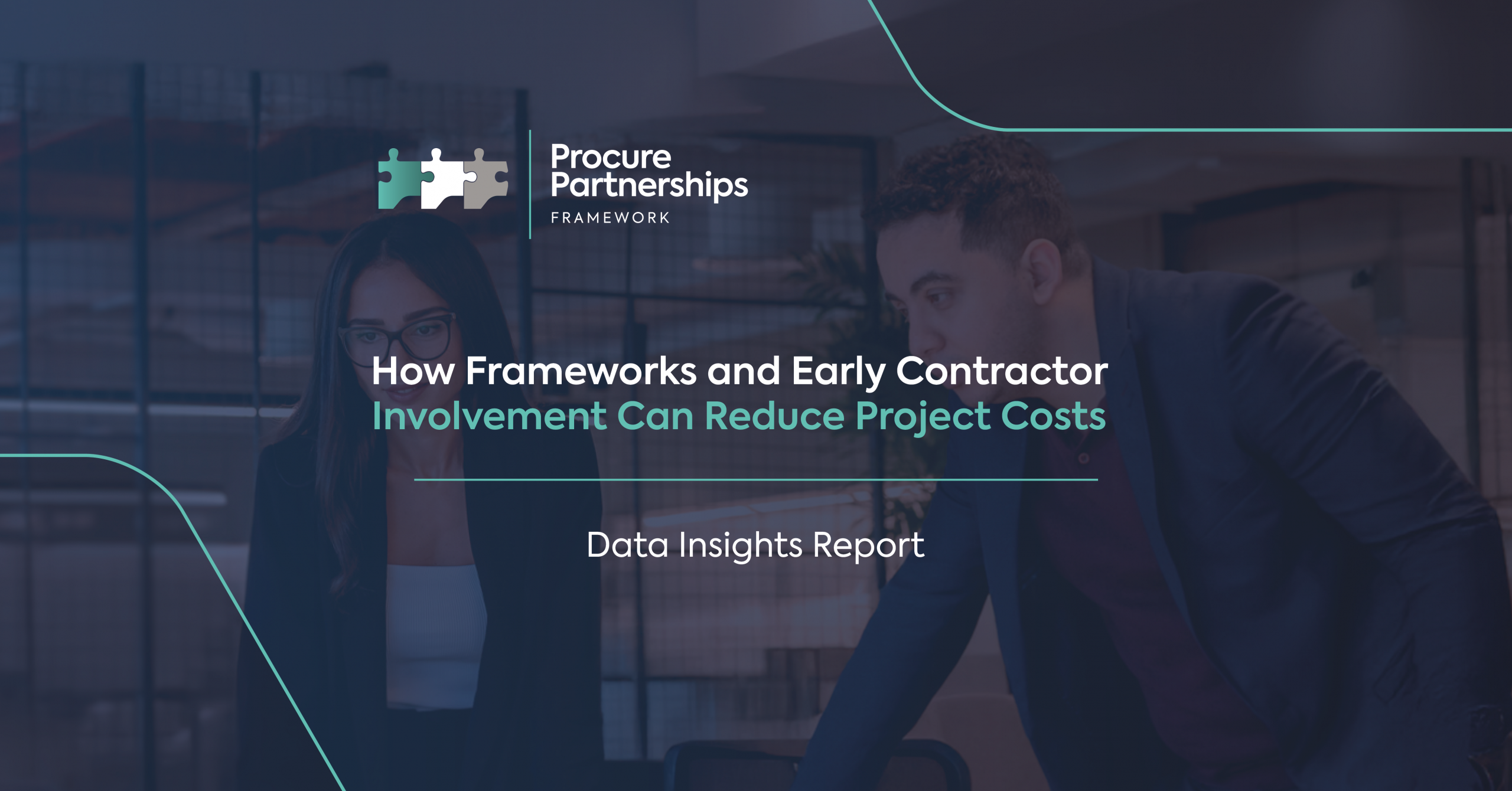Evolving regulations, unstable supply chains, workforce shortages, economic instability and sustainability targets are just some procurement challenges that make construction budgets difficult to control.
Budget control challenges bring instability and risk to public sector construction and infrastructure project delivery. How projects are tendered can significantly inflate or minimise these challenges.
While there may be a general perception of open market tenders as being fair and transparent, they are typically focused on low cost rather than quality and expertise, and open to the risk of unvetted suppliers. The evaluation of high volume tender submissions is also hugely time-consuming for clients.
Frameworks and early contractor involvement (ECI) allow public sector procurement teams to engage with suppliers who are pre-vetted, and work is completed to pre-agreed rates within a standardised approach and framework terms, ultimately protecting clients from laborious processes and commercial game playing.
Procure Partnerships Framework has compiled data that evidences how frameworks return better results in crucial cost areas by comparing internal project data to open market data. In this report, we examine the benefits of frameworks and ECI for public sector procurement, backed by data insights, and case study analysis from global consulting firm, Atkins Réalis.
Why early contractor involvement matters
Early contractor involvement allows for the contractor’s input into the design, buildability and sequencing of build projects. This approach reduces risk and the potential for costly rework. The contractor can also specify construction methods that prioritise quality and safety before any work begins. Darron Hull, Managing Quantity Surveyor at Atkins Réalis states that, “Early contractor involvement and market testing are powerful strategies that can significantly reduce project costs, especially in large-scale or complex construction projects.”
The beneficial, real-world impact on cost and risk is particularly evident in complex infrastructure projects. For example, the UK Government’s HS2 programme advocates early contractor involvement, stating “ECI improves value for money, enabling contractors to plan for recruitment, training and retention of personnel.”
Data insight: Procure Partnerships Framework vs Open Market
Procure Partnerships Framework data demonstrates the benefits to public sector clients of robust market testing and ECI for tenders within a construction framework, compared to the open market.
The data points we cover here, are:
- Cost accuracy
- Cost efficiency (per m²) in education and healthcare construction
- Preliminaries
- Overheads and profit
- Tender cost difference
Data Comparison
| Data Item | Metric | Framework | Open Market |
| Cost efficiency Education | Cost by floor area (per sqm) | £2774 (average) | Up to £3150 |
| Cost efficiency Healthcare | Cost by floor area (per sqm) | £3405 (average) | Up to £4137 |
| Preliminaries | % of project costs attributed to preliminaries | 12.04% | Up to 20% |
| Tender cost difference | Difference between highest and lowest bids received. | 24% | Up to 50%+ |
Cost accuracy
Cost accuracy measures the final project cost as a percentage, over or under the initial pre-tender estimate.
Frameworks improve cost forecasting through clearer scopes, known suppliers, and standardised terms. They provide more of a guarantee that the prices submitted at tender stage will be in line with pre-tender estimates.
This is supported by Procure Partnerships Framework data which shows framework projects have only a 1.4% variance, on average, from pre-tender estimate to agreed contract value. ECI enables accurate cost forecasting by allowing contractor input before critical decisions are made, facilitating innovative design with practical and realistic delivery methods.
Cost efficiency (per m²)
Cost efficiency is the contract value divided by the gross internal floor area (GIFA). Some factors that affect building cost efficiency per m² include location, labour rates, design complexity, material specifications and finishes.
Frameworks generally yield a lower and more stable unit cost than open market equivalents, through pre-negotiated rates and streamlined processes.
We compared the cost efficiency of Procure Partnerships Framework outcomes to open market projects for education and healthcare:
Education
| Primary education | Secondary education | Colleges | Universities | |
| Procure Partnerships Framework | £2297/sqm | £2967.44/sqm | £2019.41/sqm | £3812.42/sqm |
| Open market (average) | Up to £2675 £/sqm | Up to £3200 £/sqm | Up to £2150 £/sqm | Up to £4575 £/sqm |
Healthcare and Blue Light
| Acute healthcare | Blue Light | |
| Procure Partnerships Framework | £4157.68/sqm | £2651.38/sqm |
| Open market (average) | Up to £4500 £/sqm | Up to £3,775 £/sqm |
The lower costs per square metre demonstrate how a framework approach with ECI allows contractors to provide clearer cost analysis and engage in better dialogue for realistic price negotiation.
Robust market testing, (the evaluation of contractor interest), also improves cost efficiencies. Darron Hull, Managing Quantity Surveyor at Atkins Réalis, reinforces this point, commenting “market testing helps Identify cost-effective solutions. By comparing different suppliers and contractors, clients can find the most cost-effective options without compromising on quality.”
Preliminaries
Preliminaries evaluate the cost of contractor site setup, management and enabling works as a percentage of the total project cost. These essential yet non-permanent costs are any cost associated with delivering a construction project that doesn’t result in tangible assets or remain on site post-construction. Common examples are temporary site cabins, plant hire, hoarding and staff.
Lower preliminary costs are often achieved within a framework through the efficiencies created by standardised approaches, competitive tension and repeat collaboration.
On Procure Partnerships Framework projects, the data illustrates this clearly as tendered preliminaries average 12.04% of the overall contract value, compared with levels as high as 20% on open market procurements. A framework model encourages early contractor involvement, which facilitates the joint development of practical, cost-effective site management strategies. Additionally, pre-agreed rates and clearly defined cost expectations contribute to transparency and accountability, while the framework’s governance structure allows for independent scrutiny of submitted costs to ensure value for money is maintained throughout.
Overheads and profit
The overheads and profit data refer to the corporate overhead and profit margin as a percentage of the total project cost.
When contractors tender a framework, they are evaluated on overhead and profit percentages, and staff hourly rates, so it is in their interest to keep those costs low, and more competitive than those generally seen on the open market. Frameworks can cap or benchmark these costs during selection, supporting clients to achieve lower rates and better value for money.
Open market overheads can reach up to 15%, whereas the Procure Partnerships Framework offers competitively fixed overhead and profit (OH&P) rates that are, on average, half that of an open market procurement. This is possible because contractors offer volumetric discounts; rather than pricing based on a single project, they consider the potential for 10 to 20 project opportunities over the four-year framework period.
ECI further facilitates more efficient design and planning which results in fewer changes or rework costs. As Sarah Seasman, North West Quantity Surveying Lead at Atkins Réalis, explains, “Contractors can provide valuable input during the design phase particularly in relation to buildability, leading to more efficient and cost-effective solutions.” This collaborative approach results in more stable overhead budgets and improved outcomes across the project lifecycle.
Tender cost difference
The tender cost difference represents the variation between the highest and lowest submitted bids. In open market procurement, there are no set parameters or structures governing tender returns, often resulting in a large number of bids from suppliers who may lack the capability or capacity to deliver the project. This generates a significantly wider variance in submitted tender costs and introduces risks related to quality and deliverability.
In contrast, framework mini competitions typically show tighter spreads, reflecting known scope and fair commercial tension. Procure Partnerships Framework supports procurement teams in producing well-structured pricing documents that guide bidders effectively and reduce ambiguity. Without the structure of a framework, tender requirements are more open to interpretation, which often drives inflated or inconsistent pricing.
Procure Partnerships Framework data returns a variance of 24%, indicating submissions of structured and comparable bids. For open market tenders, the average variance percentage between the highest and lowest value bids can reach 50% or higher. Such wide variance often indicates that some suppliers may have misunderstood the scope or underpriced the work to win the contract, potentially leading to disputes, delays, or cost escalation later in the project.
Case study spotlight
Atkins Réalis is a global consultancy firm.
Authors: Darron Hull, Managing Quantity Surveyor at Atkins Réalis, and Sarah Seasman, North West Quantity Surveying Lead at Atkins Réalis.
The project: A recent local authority masterplan project including the redevelopment of the town centre, delivery of a multi-modal interchange, office space, new hotel, residential units, a market hall, and extensive public realm and highways development.
The initial phase is forecasted to see a construction cost in the order of £80 million. This is funded through the LUF (Levelling Up Funding) process by using a framework and a two-stage open book approach, and engaging contractors early.
Significant cost savings and other benefits were achieved. The use of a framework enabled a quick selection of quality tier one contractors to move forward to the two-stage tender process and accelerate the contractor involvement as soon as possible to gaining the following benefits.
- Cost savings: Frameworks holistically offer the most robust route to market, demonstrating both transparent accountability for public spend and value for money in support of project objective.
- Time and cost control: Improved project timelines and budget management, with early involvement of the contractor’s planners/developers.
- Reduced waste: Understanding costs early, alongside lean programming and value engineering helped reduce waste and carbon emissions.
- Enhanced employment and skills: The project created new opportunities for SME subcontractors and improved employment and skills outputs, meeting local authority social value requirements, including the employment of people living within the local borough.
Summary and Recommendations
- Accessing contractors with pre-negotiated and competitive rates through a framework results, on average, in a lower cost per m² across public sector projects.
- Transparency over fixed rates and early contractor engagement enabled by frameworks helps improve cost forecasting. On average, agreed contract values tend to be within 1.4% of their pre-tender estimate.
- Standardised approaches to pricing and competitive rates ensure lower preliminary percentages and keep overheads to a minimum.
- Frameworks enable earlier contractor engagement which reduces design or scope drift, meaning projects are less likely to be subject to delays, as demonstrated by the case study.
Embedding structured market testing and early contractor involvement into procurement strategies is essential to providing greater cost certainty, transparency, and delivery confidence. Procure Partnerships Framework provides a proven, streamlined route to market that delivers measurable value across all stages of a project.
Through competitive tendering, capped rates, and robust governance, we support clients in achieving clear, auditable value for money. Our performance management systems further safeguard client outcomes by continuously monitoring contractor performance, ensuring accountability, and driving continuous improvement. The result is a more predictable, efficient procurement process that reduces risk and ambiguity.



